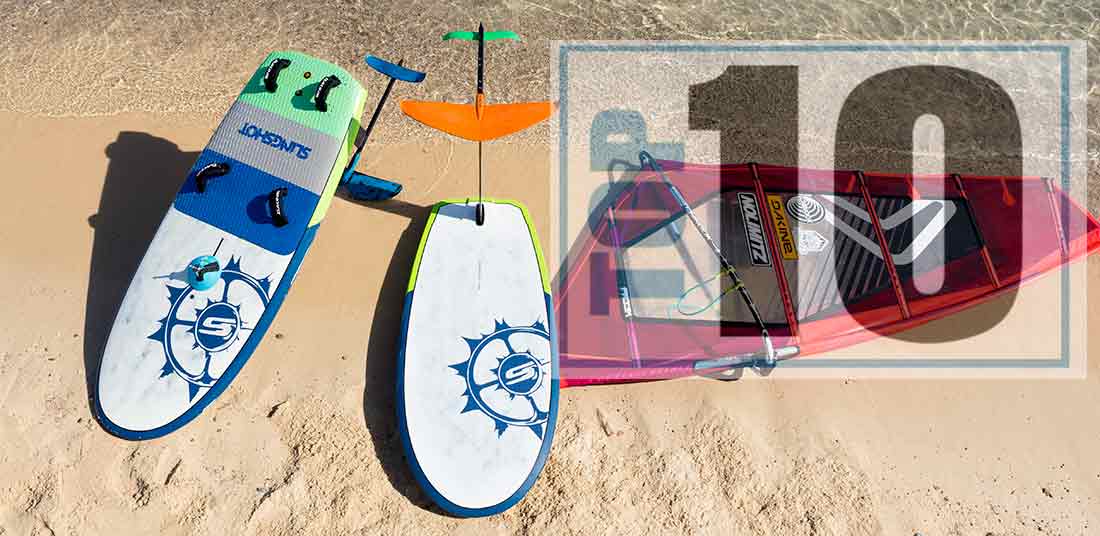
Learning to windfoil – Top 10 FAQ -We asked our customer service team to compile a list of the most frequently asked questions they receive about learning to windfoil.
1. How hard is windsurf foiling to learn?
While foiling certainly adds a whole new layer of complexity to windsurfing, learning, when done right, isn’t all that difficult if you’re a decent windsurfer. If you can try to foil behind a jetski or boat first, you’ll have a head start, and if you go through Foil Academy (www.foil-academy.com) and start with a shorter mast, you’ll be feeling the freedom of flight in no time.
2. How dangerous it?
Foils are sharp, there’s no getting around it. They need to be, for efficiency and performance. So yes, there’s definitely a level of risk that comes with it. But if you take precautions (like wearing a full wetsuit, booties a helmet and an impact vest or PFD), the risks are minimized, and once you get over the learning curve, they drop dramatically. Starting with a short mast also cuts down on the risks since it’s a lot easier to manage than jumping right in with a full-sized mast. SPOILER ALERT: 2019 SLINGSHOT HOVERGLIDE WINGS WILL ALL HAVE WINGLETS FOR SAFETY.
3. Can I use an old windsurfer board or do I need a new one?
While it’s possible to pair a Slingshot foil with any board with a tuttle box mount, we advise against it. Traditional boxes weren’t designed to handle the forces unique to wind foiling. They generally do okay with side to side torque, but not forward and aft forces, which are pretty much zero with a traditional fin but quite high with a foil. If you do use your old light-wind board, keep a close eye for any cracks or dimples in and around the box, and you may want to add some kind of leash to keep your foil from sinking if/when the box fails.
4. What shape of board is the best for foiling?
In general, shorter, wider and higher volume. Since you’ll be in light-wind, you want a board with enough volume to uphaul with, and just enough length to pump up and get on-foil. Once you’re flying across the water, you want a board that feels like a sports car, not a school bus. Tail and rail shapes are also different for dedicated foil boards. You’ll notice beveled edges and notched tails,
which help with early release off the water and prevent the edge from engaging during brief touchdowns. Last but not least, a wide scooped nose is hugely helpful for preventing pearling and rebounding off the water during touchdowns.
5. What size and type of sail do I need?
The good news here is the sails you already have will work just fine. What size to rig will depend on your level of progression and the foil you have (speed vs. lift), but in general 1-2 meters smaller than what you would use normally is a good start. A general guideline for learning is if you can waterstart with the sail you’re on, it’s probably too big. Rig to uphaul. Once you’re on foil, you’ll be happy as a clam.
6. Is learning with a short mast really necessary?
It’s a big help in learning, by all means, start shorter, even if it’s just a session or two. You won’t rise out of the water as far, which means you’ll touch down softer and crash less. Less time in the water, more time learning to fly- that makes sense to us.
7. How good of a windsurfer do I need to be?
Honestly, the learning curve for wind foiling is surprisingly fast. If you’re a decent windsurfer, you’ve already put in most of the time and energy necessary to learn to foil. We’ve seen strong sailors but first- time foilers go out with a short mast and get their first controlled flights within an hour.
8. What’s the best wind speed for learning?
Somewhere in the 15knot range seems to be about the sweet spot for learning. Once you’re proficient at pumping your board and sail to generate speed for takeoff you can go a lot lighter, but until then you want enough wind to easily get on plane and foiling, but not so much that you’re flying out of control once you get up. Smooth water is also a big help for learning, which means even though you can just rig down in stronger wind, you’ll be better off saving that until you get a few good sessions under your belt.
9. Can I use a kite foil for windsurfing?
If you’re an expert foiler, you weigh about 100 pounds and you go out in strong wind, sure. For everyone else, not really. In addition to the proper Tuttle box connection, a windsurf-specific foil has a longer fuselage and larger wings designed to give the lift need to get yourself and all your gear out of the water in light wind, and the stability to cruise and carve freely once you’re foiling.
10. How do I get started?
Easy, before you do anything, check out Foil Academy at www.Foil-Academy.com. There’s a windsurf- specific course that covers all the basics you need to know to learn how to foil. It’s free, full of useful information and guaranteed to save you time and energy on the water.

